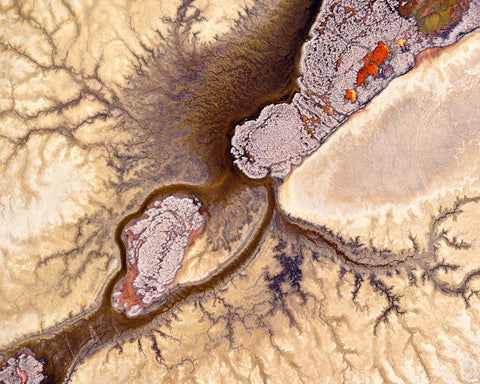26 August 2021
Like nowhere else on Earth – amazing photos of the Territory win at Australian Geographic Nature Photography Awards
Photographer Tim Wrate risked life and limb hanging halfway out of a plane to capture the Northern Territory like you’ve never seen it before.
Depicting desolate wastelands contrasted by sprawling wetlands teaming with life, floodplains punctuated by twisted rivers and the vast expanse of the almost untouched outback, Tim Wrate’s work is simply breathtaking.
It’s no wonder then that his aerial images of the Northern Territory won the Portfolio Award at the 2021 Australian Geographic Nature Photographer of the Year Awards announced on Thursday 26 August.
With 2200 entries from professional, junior and emerging photographers from seventeen countries, submitting their nature and wildlife photographs from the bioregion of Australia, New Zealand, Antarctica and the New Guinea. Any photographer with six or more entries is automatically entered in the Portfolio category with Mr Wrate beating out an impressive field in 2021.
Two of the images were captured on a charter flight from Darwin over Bynoe Harbour, the remaining four were captured on a charter flight from Katherine to Ngukurr over the Limmen Bight and Roper River area of Southern Arnhem Land at the end of long, hot dry season
Mr Wrate said capturing the landscape from the air was about providing new insights into familiar scenes.
“For me, the most appealing aspect of aerial photography is the ability to look past the obvious and find interpretive meanings, in one of the awarded images, stagnant water in a floodplain appears to be the flames of a fire rising or perhaps even the wing of an insect,” said Mr Wrate.
Aerial photography is not without its challenges though with Mr Wrate acting as a navigator, battling wind, heat and harsh conditions to capture these amazing landscapes.
“Working out of an open window of a light aircraft means dealing with some serious wind buffeting, wash from the propeller, high frequency vibrations from the engines and sometimes severe aircraft movements.
“As I move through the air, I find myself multi-tasking; from grappling with my equipment, dialling in the best technical settings on my camera, working to shoot powerfully composed images and keeping up with the rapidly changing perspective, all while communicating with the pilot to orchestrate the best flight path."
Mr Wrate’s portfolio is the first Portfolio Prize awarded to a portfolio entirely comprised of aerial images since the competition’s inception in 2003.
The winners of the Australian Geographic Nature Photographer Awards were announced on Thursday 26 August 2021. The Australian Geographic Nature Photographer of the Year competition and resulting exhibition is run annually by the South Australian Museum. Australian Geographic is the principal sponsor.
For all more information and to see shortlisted entries and see the winners for each category please visit: https://www.samuseum.sa.gov.au/c/npoty/gallery
To read Mr Wrate’s full blog on the trip and to view more of his work visit www.timwrate.com.au.
Image Title: Fabrica

Category: Landscape
Background: Flying over the remote Limmen Bight region of the far western Gulf of Carpentaria was one of the single most incredible experiences of my photographic career. What may be ordinary from the ground can be extraordinary from above – this image is the perfect example of that.
Location: Southern Arnhem Land, Northern Territory
Technical Information: Fuji GFX 100, GF 110mm f/2, 1/1800, f/5.0, ISO 250, handheld, captured from a Cessna 210 at 2000 feet
Image Title: Ebb and Flow

Category: Landscape
Background: Ebb & Flow was captured at 2500 feet above Bynoe Harbour, where the tidal variations of 5.8m expose extensive seabeds and variations in sand banks that contrast wonderfully with the impossibly blue water of the Northern Territory.
Location: Bynoe Harbour, Northern Territory
Technical Information: Fuji GFX 100, GF 110mm f/2, 1/1900, f/5.0, ISO 200, handheld, captured from a Cessna 210 at 2500 feet
Image Title: Rise

Category: Landscape
Background: Captured above ephemeral floodplains, the electric colours and intricately textured patterns are where the waters of a standing swamp have seeped out on to the extensive floodplain network. The colours are primarily the result of a mix of high salinity levels, algae, and a long, hot dry season.
Location: Southern Arnhem Land, Northern Territory
Technical Information: Fuji GFX 100, GF 110mm f/2, 1/2500, f/5.0, ISO 400, handheld, captured from a Cessna 210 at 2000 feet
Image Title: Balance

Category: Landscape
Background: Low tide exposes the seabed and rock shelf of Bynoe Harbour. The patterns created by the receding water are really intriguing and the warmth in the bottom left balances the cool of the top right perfectly, giving the image a sense of rhythm.
Location: Bynoe Harbour, Northern Territory
Technical Information: Fuji GFX 100, GF 110mm f/2, 1/2500, f/5.6, ISO 320, handheld, captured from a Cessna 210 at 2000 feet
Image Title: Tracks

Category: Animal Habitat
This picture was captured at 2000 feet above the intertidal floodplains between the Roper and Limmen Bight Rivers on the remote shores of the Gulf of Carpentaria. The floodplain is punctuated by water buffalo tracks meandering to and from the island. Look closer and you may find water buffaloes basking in mud wallows.
Location: Southern Arnhem Land, Northern Territory
Technical Information: Fuji GFX 100, GF 110mm f/2, 1/2700, f/4.5, ISO 160, handheld, captured from a Cessna 210 at 2000 feet
Image: Mangrove Dieback
Background: During the summer of 2015–16, one of the worst mangrove dieback events ever recorded devastated around 7400ha of mangrove forests along more than 1000km of Gulf of Carpentaria coastline. The unfortunate consequence of unseasonably high temperatures and dry wet seasons caused by climate change.
Location: Southern Arnhem Land, Northern Territory
Technical Information: Fuji GFX 100, GF 110mm f/2, 1/750, f/5.0, ISO 200, handheld, captured from a Cessna 210 at 1500 feet

